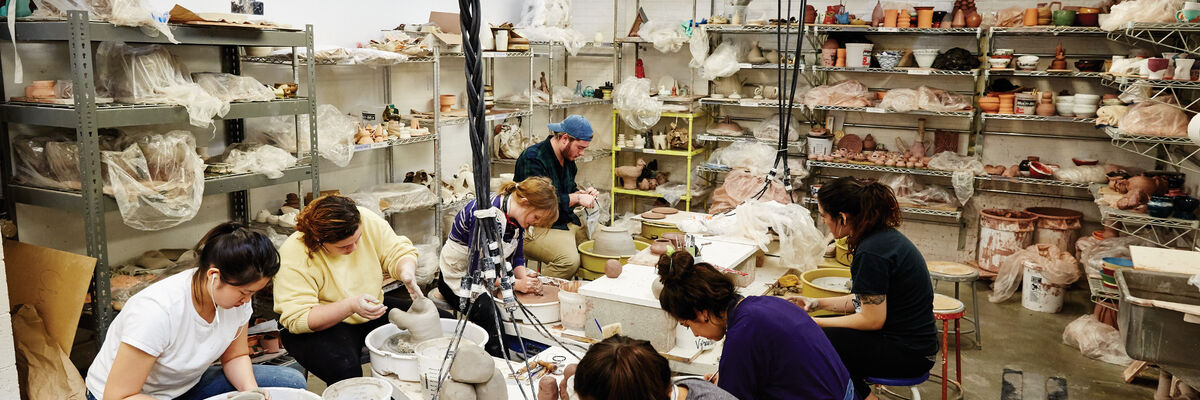
Truth, Action, Education
How artist collective AFRICOBRA helped reshape the mindset of Black communities
by Adrienne Samuels Gibbs

It was 1968, the tail end of the civil rights movement and the beginning of Black Power—a movement of artists and activists calling for racial pride, economic empowerment, and political and cultural change. Amid this atmosphere of activism and critique, five artists (four of them SAIC alums) formed a revolutionary collective that would create functional art expressing statements of truth, action, or education. They called themselves the African Commune of Bad Relevant Artists, AFRICOBRA for short.
In the decades since, members of the group spread out across the country, raising families and teaching art. While they and their art have evolved, they never abandoned the group, which made headlines this spring with exhibitions at the Museum of Contemporary Art North Miami, the Broad museum in Los Angeles, and at the 2019 Venice Biennale.

“The things we said are just as relevant today as they were when we did it in the ‘60s. What AFRICOBRA was about was changing how art is looked at. We weren’t worried about it looking like mainstream White art,” says Wadsworth Jarrell (DIPLOMA 1958), a founding member of the group along with his wife, Jae Jarrell (SAIC 1959–61).
According to SAIC Professor of Visual and Critical Studies Romi Crawford, who co-authored The Wall of Respect: Public Art and Black Liberation in 1960s, the need for uplifting imagery in the Black community that led to the creation of AFRICOBRA still exists today, and that’s why many younger artists are gravitating to their work. The messages they present never lose power or interest, she says.
We’re doing the future. We’re doing uplift. It was beautiful because it was addressing and including Black people.
The five original members—Wadsworth and Jae Jarrell, Jeff Donaldson, Barbara Jones-Hogu (BFA 1964), and Gerald Williams (SAIC 1966–67)—began meeting after Donaldson asked them to stop by the Jarrells’ studio. Several of the members had worked together on the Wall of Respect, a mural depicting celebrated Black leaders that challenged the status quo while also boldly accentuating nation-building messages about self-worth and direction. It was a revolutionary idea to show the power of Black people. The mural, which sparked a community mural movement across the country, became a gathering space for the Black community, a site of music and spoken word performances.

Following that success, the artists began meeting on Sunday afternoons in the Jarrells’ studio to talk about what was going on in the Black community. Conversations turned to the power of coming together as a group to address the suffering of the Black community by proposing solutions through art. According to Jae, making art was an ego-driven activity, until they considered joining together. “The reason we didn’t find our individuality threatened is because we each thought we could blow the world away. We felt accomplished, and as accomplished artists, you can do something for a hurting community,” she explains. “We retired our ‘I’ and attained a ‘we’ to be more impactful for our people. We’re doing the future. We’re doing uplift. It was beautiful because it was addressing and including Black people,” she says.


Their first exhibition focused on the Black family. Using their signature “cool-ade” colors, positive imagery, and text, the artists offered a new narrative about the Black community, one that showed pride and strength. “We were trendsetters. We didn’t jump on bandwagons and make protest art,” says Wadsworth.
The group remained committed to the tenets of direct messages, bright colors, and positive imagery even as it grew in numbers and broadened to an international vision. Napoleon Jones- Henderson (BFA 1971), who joined the group in ‘69, explains the idea of “shine” that was central to the work and its connection to the Black community: “‘Shine’ is about being brilliant and being highly illuminated as an aesthetic element.”
We were trendsetters. We didn’t jump on bandwagons and make protest art.

Members of AFRICOBRA have taken this message around the world with exhibitions in Europe and participation in the Second World Black and African Festival of Arts and Culture in the ‘70s, an event described by the Tate Modern as, “the turning point in the development of a black global consciousness.” Closer to home, their work continues to have a profound impact on today’s students at SAIC. Jae returned to campus in 2015 to participate in a panel discussion, “The Women of AFRICOBRA,” organized by D. Denenge Duyst-Akpem (MFA 2004), adjunct assistant professor of Art History, Theory, and Criticism at SAIC, who has worked with Jae in her studio. Duyst-Akpem calls herself a “space sculptor,” and echoes of AFRICOBRA’s message of empowerment can be seen in her work. She teaches her students how AFRICOBRA empowered a nation to look at art in a new way.


Jae herself also taught for many years, sharing her passion for art with students, and her daughters Jennifer (BFA 1994) and Roslyn (SAIC 1991–95) became artists. And while she continues to create work and exhibit with AFRICOBRA, she has always maintained a strong individuality and encourages others to do the same. To today’s emerging artists, she says, “Trust your choices. Trust your mistakes and that you will make better choices. It’s all a refinement of self. You have to be fulfilled, otherwise you will tread and tread and tread without dynamic contributions.”
